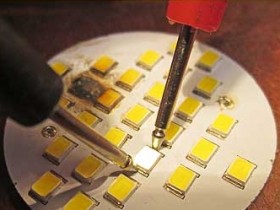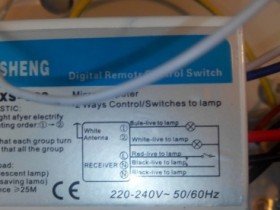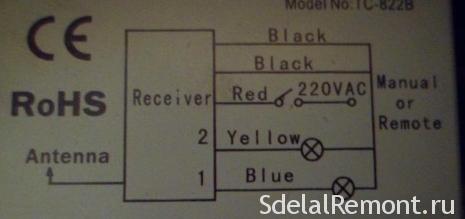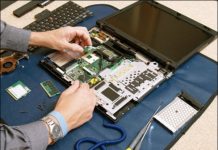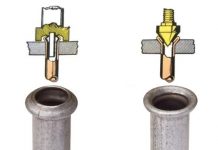In detail: DIY repair of LED chandeliers with a control panel from a real master for the site my.housecope.com.
Lighting technologies are constantly evolving, which allows each owner to make their home more cozy and comfortable. Today, chandeliers that are controlled by a remote control are gaining popularity. Such chandeliers are convenient in everyday life, easy to operate, easy to install and connect. However, like most cheap Chinese products, they break down periodically and chandeliers need to be repaired. Many owners who are not versed in electronics turn to the masters. Nevertheless, knowing the general structure of such lighting devices and having the skills of electrical work, it is quite possible to repair chandeliers with a control panel with your own hands.
Lighting devices controlled by a remote control have a rather complex design. In order to assemble and connect them, you will need certain knowledge and skills in electronics and electrical engineering. Chandelier a can work effectively at a considerable distance, and the desired lighting mode is set using the buttons on the remote control by a set of simple combinations. The number of functions depends on the design and model of the chandelier.
Everything chandeliers with a remote control are divided into several types:
- With LED bulbs. The design includes several multi-colored LEDs that affect the gradually changing color of the backlight. Basically, these luminaires have a decorative function and break quite often. The LEDs are powered by a capacitor that reduces the voltage to an optimal value. The LEDs are connected in series, so if one of them burns out, the entire circuit goes out. As a rule, during the repair process, not individual LEDs are replaced, but the entire unit at once.
- With halogen lamps. To power such lamps, transformers are used that perform a pulse conversion of the supplied voltage. In the event of a breakdown, each of the lamps is checked in turn with a multimeter. If the lamps are operational, a check is carried out on all available transformers.
- With combined light sources. These chandeliers have the most sophisticated design, combining LED and halogen lamps. They can be turned on one by one or all together. In the event of a breakdown, deficiencies characteristic of the first two types of chandeliers are revealed.
| Video (click to play). |
All chandeliers are equipped with a radio control relay, in which a module is installed that receives a radio signal from the remote control. Each model is distinguished by a certain number of electromagnetic relays that switch currents of different powers.
Power to the relay is supplied through a quenching capacitor, and surplus electricity is neutralized by a ballast capacitor. A significant drawback of this element is the place where it is soldered into the common board. During long-term operation, the soldering becomes weaker, and the relay can fall off at any time.
The most important part of the chandelier is the remote control itself. It is distinguished by its simplicity of design, the minimum number of buttons and a set of functions. Therefore, it is quite possible to repair chandeliers with a remote control yourself. A simple electrical circuit guarantees long-term operation, so the remote control most often fails due to dead batteries.
Chandeliers controlled from a distance and operating in different modes are more susceptible to failure than other lighting fixtures. Breakdowns can begin with faulty batteries and end with serious malfunctions of power supplies, controller and software board.
The main symptoms of malfunctions typical for controlled luminaires:
- When a signal is sent from the remote control, the lamps on the chandelier do not turn on.
- Some lighting modes do not work, the lamps may turn off spontaneously.
- The modes are not switched using the remote control, but they work quite fine with manual switching.
- Chandelier a spontaneously blinks, switches between modes independently.
These malfunctions are most common, but they practically do not appear at the same time. As a rule, replacement of 1-2 elements is required during repair. Therefore, first of all, we determine the breakdown of the most important elements. The most difficult part is finding faulty parts and replacing them. Usually searches begin with checking the batteries. If this is not the reason, then you need to look further.
Different types of light bulbs can be grouped in separate blocks. Multiple instruments and components are responsible for the normal operation of each of them. For example, blocks are connected into a single structure using a controller. If the batteries in the remote control are replaced, but it still does not work, you can try to start the chandelier with the switch. In the event of an unsuccessful start, it is highly probable that the controller is the cause of the malfunction. Therefore, the remote control and controller are checked for operability.
In some cases, the controller is able to start only individual modules of the system when the LEDs are on, but the halogen lamps do not start. In such a situation, the problem may lie in the halogen lamp module requiring repair. It is recommended to check all contacts and the quality of their attachment. After that, power supplies and transformers are tested, which can burn out when using too powerful lamps.
Last of all, the operability of the LED lamps is checked. In some cases, they can all burn out at once due to the instability of the electrical circuit, sudden voltage drops. A burnout can be caused by a power supply unit and a transformer with too much power.
The most common causes of breakdowns and frequent failure of LED lamps are associated with the design features of these elements. Their miniature parts are subject to severe wear and tear due to high input voltages, improper wiring and other negative factors. The simplest way to check is to connect a light bulb to another luminaire, after making sure that it is working properly. In addition, the performance of the LEDs can be tested with a dedicated LED tester. It must be remembered that these bulbs are not repairable and must be replaced. As a rule, the entire faulty group of lamps is changed.
After the malfunctions have been found, it is necessary to take measures to eliminate them. As an example, it is recommended to consider the most common breakdowns and ways to eliminate them.
In the process of deciding how to repair chandeliers with a control panel, one should not forget about increased caution. This is due to the application of voltage to the bare wires. Inattention and non-observance of electrical safety rules can lead to electrical injury and more serious negative consequences.
Savings and design in lighting have brought cutting-edge technology to nearly every home. Many people change their common base chandeliers for economical LED products. Not everyone knows how to repair an LED lamp on their own, especially what parts it consists of inside. How to use the tool in case of breakdown, where to start the whole process.Let's try to figure out in detail what are the breakdowns in the devices and how to repair some LED chandeliers with our own hands.
- Typical breakdowns: partial or complete lack of lighting, short blinking or spontaneous shutdown, failure. Reasons: The temperature has reached above 50 degrees, a break in the contact between the filament itself and the holder, if it is a paid option, and not a lamp one, peeling of the contacts on the board.
- The LED is burnt out, partially or completely. Reason: Overvoltage in the network, capacitor burned out (breakdown). Usually breakage occurs in cheap board options.
- There are additional reasons leading to the failure of the device, namely: a short circuit in the circuit, incorrect connection to the network, non-observance of the device connection diagram during installation.
- Poor soldering of the contacts of the circuit, LEDs to the board, poor fastening of the wires in the base of the lamps. Weak soldering of conductive elements (wires, tires). Reason: Factory defect. The repair of many LED chandeliers with a control panel is carried out for this very reason.
Before repairing the LED light, the fixture must be removed. It will take some tool; thin screwdriver with a flat end, cruciform. If the connection was made using twists, you will need pliers with insulated handles, insulating tape and a multimeter to check the contacts. Tweezers come in handy when working with small parts.
You will need a soldering iron with a thin tip and solder (it is advisable to use a special nozzle). A drill with a 2.5 mm drill., It can also come in handy, disconnect the base of the lamp by drilling out the fasteners. Several thin wires 10 cm long.
Attention! It is forbidden to carry out electrical work without a special protected tool!
Chandeliers appeared with a remote control not so long ago. Few people are familiar with their device. Repairing LED ceiling
A simple LED chandelier consists of a body, a regulator unit, or a driver. It is used as a voltage rectifier. It contains terminals, or terminal clamps, to which the mains power is connected. Then wires run from the block to the lamps. They can be from one wire, for a regular lamp, up to 12 for a design version of the device.
A more complex version of the product, consists of an antenna, a control unit for the lighting itself, a voltage regulator or several
In multiple blocks carrying out automatic tuning. Raster luminaires can have several drivers and different types of LED elements, lamps. From a specific type of lighting
Why is it necessary to know or find out the design before
start repairing your LED chandelier. The reason is simple, you need to determine where the control units are located, inside the chandelier or in
the lighting element itself, the lamp. Here we need the same LED chandelier circuit.
Repairing an LED chandelier working without a remote control is easier. There is nothing complicated in it, they are assembled according to the same type: one or more diodes (a compact bridge is possible), electrolytes (capacitors), a pair of resistances (resistors), and a coil with a winding. This is the simplest scheme without protection, there are many options for them, but now we will analyze the simplest scheme.
- After removing the lamp, inspect the board for visible defects, broken wires, oh
The absence of such is a good sign.
- Remove the shade or decoration around the lamp, unscrew the lighting elements. Examine the base, burnt spots indicate poor contact. If there are any, try cleaning them with a knife.
- Repack the terminal blocks, or twists, tighten the screws on all parts. Not finding visible defects, we proceed to inspect the lamps.The version of a block luminaire, where relays and lamps are next to each other on a large board, is considered as repairing the lamp described below.
- Do-it-yourself LED chandelier repair begins with determining the location of the breakdown or breakage.
Fix the lamp with a smaller diameter plastic bottle by cutting and inserting the lamp into it.
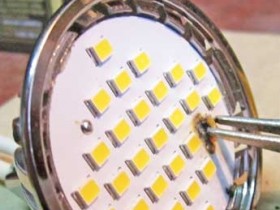
It is better to supply power with a separate power supply, to the lamp, if it is 12 or 24 volts nominal. All undamaged LEDs in the circuit need to ring the device. But the way is easier, by connecting the lamp to the power supply to carry out simple manipulations
- Alternately close (throw a jumper) the contacts of each LED with tweezers or a wire with stripped and tinned contacts.
- The lamp will light up when you find (close the contacts) on the burned out LED. If this does not happen, see further down the chain.
- Check the board for the cause of burnouts, swelling of capacitors, carefully check the tracks on the regulator board itself. Solder the broken contacts.
You cannot replace the LED with a jumper when there are less than 10 of them in the common circuit, the capacitors will overload, block LEDs will burn out when there are 3 of them in one case. They can be identified by three dark points, inside a yellow or white crystal.
Often the repair of LED chandeliers must be done due to overheating of the matrix itself. First, unscrew the fasteners and visually inspect the inside of the chandelier. Then they carefully try to move the board in place. It is determined whether there is a break in the wires from the control unit, whether the wire is burnt out from overvoltage. If burnt out, solder in place. We check all the details one by one.
Then you will need an original chandelier diagram. Without it, you can only repair the chandelier without a remote control. If there is a remote control unit, the batteries in it are replaced with new elements. LED chandeliers with a control panel are often found; here you will need an exact diagram of the chandelier controller to detect a breakdown.
The chandelier control unit is usually tightly sealed in a shell, and manufacturers draw diagrams on it. Only these are wiring diagrams and lighting elements.
There are also blocks with a collapsible body, then the option is simplified. With a non-collapsible unit, use a tester to call the output signal to the lighting elements (LEDs). In the absence of voltage supply, the reason may be a breakdown of the signal receiver. We disassemble it, visually check the contacts and tracks on the board, the integrity of the parts. If the voltage supply goes to one lighting branch, then there is a breakdown in the control unit, and not in the signal receiver itself.
The burned-out part can be evaporated and called, for a start, all the resistances (see the diagram) by putting the OMa icon on the device. Then the capacitance of the capacitors, since they have designations, polarity and type are also important when checking.
If a discrepancy is found in the denomination, re-solder.
The chandelier control unit is responsible for the intensity and modes of combustion of the LED elements. Violation of one of the circuits (in the plafond version of the lamp) does not disable the unit, possibly a fuse has blown.
But still, check the blocks, if there are any melted spots on them, there is, replace it with a new one. If the wires are incorrectly connected, only the parts in the power supply are lit. The regulator unit is protected against excessive loads. It can be called according to the scheme.
Many models of regulators, drivers and power supplies for LED luminaires come with cooling heatsinks. They have a seat through which the microcircuit or other control element gives off heat. Most lamps have radiators.
Lack of special grease, thermal paste, the cause of overheating of most (up to 15%) boards and blocks. Unscrew and check if it is applied along the plane of the seat.
The thermal paste is applied in a thin layer over the entire surface of the seat, a large amount will only worsen the heat transfer.By screwing an additional thin aluminum plate to the radiator, it is possible to increase the heat transfer, while the installation is carried out without blocking the main air flows passing through it.
As you can see, there is nothing unusual in the repair of LED ceiling chandeliers, no. It is not so difficult to do it yourself. It takes a little patience, a little practice and a tin of knowledge. Of course, the variety of lamps, lamps and all kinds of chandeliers will not make us bored during the renovation process. But in this number of details, the exact diagram of the LED chandelier and, of course, a great desire will help us figure it out.

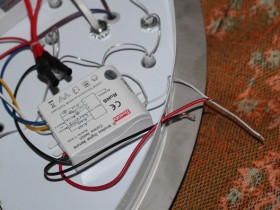
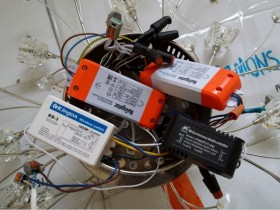
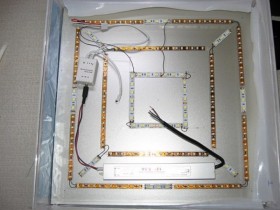 The absence of such is a good sign.
The absence of such is a good sign.